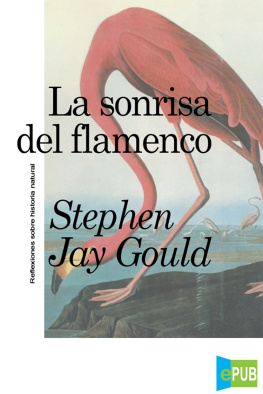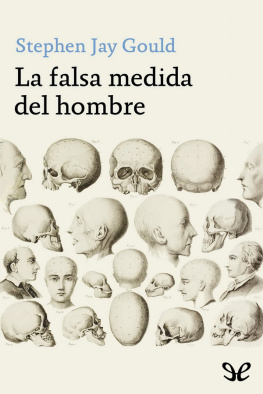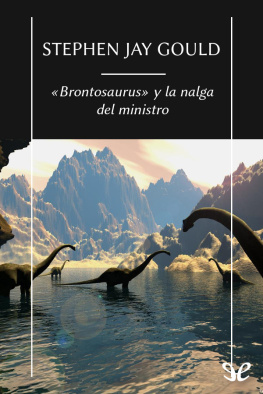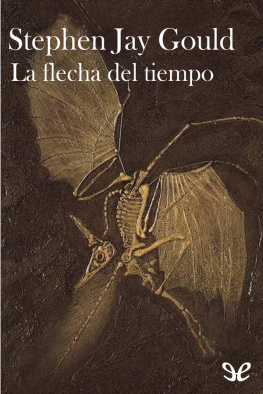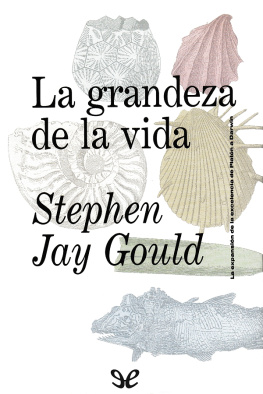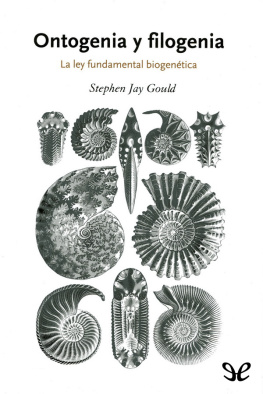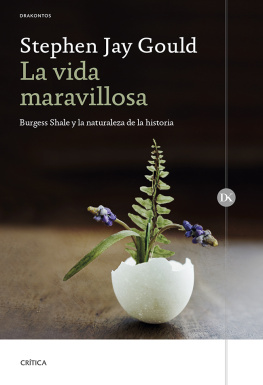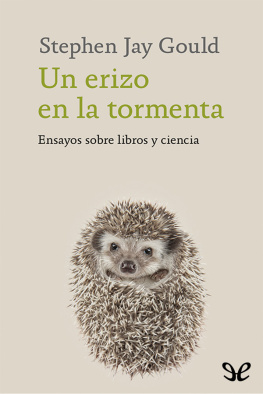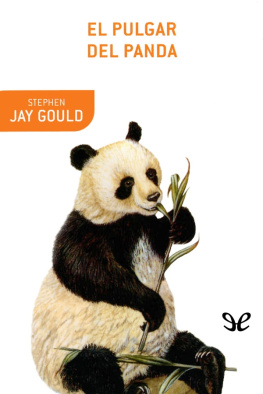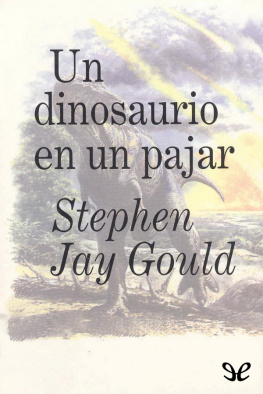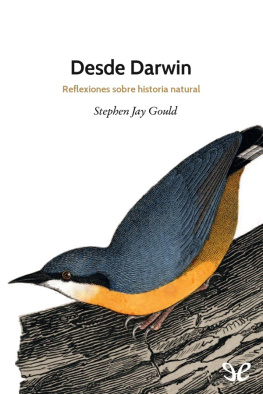
STEPHEN JAY GOULD (Nueva York, 1941 - 2002) fue un paleontólog, biólogo evolutivo, historiador de la ciencia y uno de los más influyentes y leídos divulgadores científicos de su generación. Gould pasó la mayor parte de su carrera docente en la Universidad de Harvard y trabajando en el Museo Americano de Historia Natural de Nueva York. En los últimos años de su vida, impartió clases de biología y evolución en la Universidad de Nueva York, cercana a su residencia en el SoHo.
La mayor contribución de Gould a la ciencia fue la teoría del equilibrio puntuado que desarrolló con Niles Eldredge en 1972. La teoría propone que la mayoría de los procesos evolutivos están compuestos por largos períodos de estabilidad, interrumpidos por episodios cortos y poco frecuentes de bifurcación evolutiva. La teoría contrasta con el gradualismo filogenético, la idea generalizada de que el cambio evolutivo se caracteriza por un patrón homogéneo y continuo. La mayor parte de la investigación empírica de Gould se basó en los géneros de caracoles terrestres Poecilozonites y Cerion y además contribuyó a la biología evolutiva del desarrollo. En su teoría evolutiva se opuso al seleccionismo estricto, la sociobiología aplicada a seres humanos y la psicología evolucionista. Hizo campaña contra el creacionismo y propuso que la ciencia y la religión sean considerados dos ámbitos distintos, o «magisterios», cuyas autoridades no se superponen (non overlapping magisteria).
Muchos de los ensayos de Gould para la revista Natural History fueron reimpresos en libros entre los que sobresalen Desde Darwin y El pulgar del panda. Sus tratados más populares incluyen libros como La falsa medida del hombre, La vida maravillosa y La grandeza de la vida. Poco tiempo antes de su muerte, Gould publicó un largo tratado recapitulando su versión de la teoría evolutiva moderna llamado La estructura de la teoría de la evolución (2002).
•
Bibliografía
Agassiz, L. 1862. Contributions to the natural history of the United States. Vol. 4. Boston.
Altick, R. D. 1978. The shows of London. Cambridge, MA: Harvard University Press.
Alvarez, L. W. 1982. Experimental evidence that an asteroid impact led to the extinction of many species 65 million years ago. Proceedings of the National Academy of Sciences 80: 627–42.
Alvarez, L. W.; W. Alvarez; F. Asaro; and H. V. Michel. 1980. Extraterrestrial cause for the Cretaceous-Tertiary extinction. Science 208: 1095–1108.
Alvarez, W., and R. A. Muller. 1984. Evidence from crater ages for periodic impacts on the earth, Nature 308: 718-20.
Anonymous. 1969. What will happen to geology, Nature 221: 903.
Barnes, C. W. 1980. Earth, time and life. New York: John Wiley.
Bateson, G. 1979. Mind and nature. New York: E. P. Dutton.
Beadle, G. W. 1980. The ancestry of corn. Scientific American, January, pp. 112–19.
Bigelow, R. P. 1900. The anatomy and development of Cassiopea xamachana. Memoirs Boston Society of Natural History 5: 191–236.
Briggs, D. E. G.; E. N. K. Clarkson; and R. J. Aldridge. 1983. The conodont animal. Lethaia 16: 1–4.
Buckland, W. 1823. Reliquiae diluvianae; or, observations on the organic remains contained in caves, fissures, and diluvial gravel, and on other geological phenomena attesting the action of a universal deluge. London: John Murray.
Buckland, W. 1836 (1841 edition). Geology and mineralogy considered with reference to natural theology. Philadelphia: Lea and Blanchard.
Buffon, G. L. 1828. Oeuvres complètes de Buffon. Edited by M. A. Richard. Vol. 28. Paris: Baudouin.
Burchfield, J. D. 1975. Lord Kelvin and the age of the earth. New York: Science History Publications.
Buskirk, R. E.; C. Frohlich; and K. G. Ross. 1984. The natural selection of sexual cannibalism. American Naturalist 123: 617–25.
Colbert, E. H.; R. B. Cowles; and C. M. Bogert. 1946. Temperature tolerances in the American alligator and their bearing on the habits, evolution, and extinction of the dinosaurs. Bulletin of the American Museum of Natural History 86: 327–74.
Coon, C. 1962. The origin of races. New York: A. A. Knopf.
Cuvier, G. 1817. Extrait d’observations faites sur le cadavre d’une femme connue à Paris et à Londres sous le nom de Vénus hottentotte. Mémoires du Muséum d’Histoire Naturelle 3: 259–74.
Darwin, C. 1859. On the origin of species. London: John Murray.
Darwin, C. 1871. The descent of man and selection in relation to sex. London: John Murray.
Davis, M.; P. Hut; and R. A. Muller. 1984. Extinction of species by periodic comet showers. Nature 308: 715–17.
Dobzhansky, T.; F. J. Ayala; G. L. Stebbins; and J. W. Valentine. 1977. Evolution. San Francisco: W. H. Freeman.
Dyson, F. 1979. Disturbing the universe. New York: Harper and Row.
Ehrlich, P. R.; C. Sagan; D. Kennedy; and W. O. Roberts. 1984. The cold and the dark. The world after nuclear war. New York: W. W. Norton.
Eiseley, L. 1958. Darwin’s century. New York: Doubleday.
Garrett, P., and S. J. Gould. 1984. Geology of New Providence Island, Bahamas. Geological Society of America Bulletin 95: 209–20.
Goldschmidt, R. 1940 (reprinted 1982 with introduction by S. J. Gould). The material basis of evolution. New Haven: Yale University Press.
Gosse, P. H. 1857. Omphalos: An attempt to untie the geological knot. London: John Van Voorst.
Gould, S. J. 1977. Ever since Darwin. New York: W. W. Norton.
Gould, S. J. 1977. Ontogeny and phylogeny. Cambridge, MA: Belknap Press of Harvard University Press.
Gould, S. J. 1980. The panda’s thumb. New York: W. W. Norton.
Gould, S. J. 1981. The mismeasure of man. New York: W. W. Norton.
Gould, S. J. 1983. Hen’s teeth and horse’s toes. New York: W. W. Norton.
Gould, S. J., and C. B. Calloway. 1980. Clams and brachiopods —ships that pass in the night. Paleobiology 6: 383–96.
Gould, S. J., and D. S. Woodruff. 1978. Natural history of Cerion VIII: Little Bahama Bank - a revision based on genetics, morphometrics, and geographic distribution. Bulletin of the Museum of Comparative Zoology 148: 371-415.
Grew, N. 1681. Musaeum regalis societatis, or a catalogue and description of the natural and artificial rarities belonging to the Royal Society and preserved at Gresham Colledge, whereunto is subjoyned the comparative anatomy of stomachs and guts. London: Thomas Malthus.
Guenther, M. 1980. The changing Western image of the Bushmen. Paideuma 26: 123–40.
Haeckel, E. H. 1869. Über Arbeitstheilung in Natur und Menschenleben (On the division of labor in nature and human life). Berlin.
Haeckel, E. H. 1888. Report on the Siphonophorae collected by HMS Challenger during the years 1873–1876. Voyage of HMS Challenger, Zoology, Vol. 28.
Hearnshaw, L. S. 1979. Cyril Burt, psychologist. London: Hodder and Stoughton.
Hoagland, K. E. 1978. Protandry and the evolution of environmentally-mediated sex change: A study of the Mollusca. Malacologia 17: 365–91.
Howard, L. O. 1886. The excessive voracity of the female Mantis. Science 8: 326.
Huxley, T. H. 1849. The oceanic Hydrozoa observed during the voyage of HMS «Rattlesnake» in the years 1846–1850. London: The Ray Society.
Huxley, T. H. 1863. Evidence as to man’s place in nature. London: Williams and Norgate.

